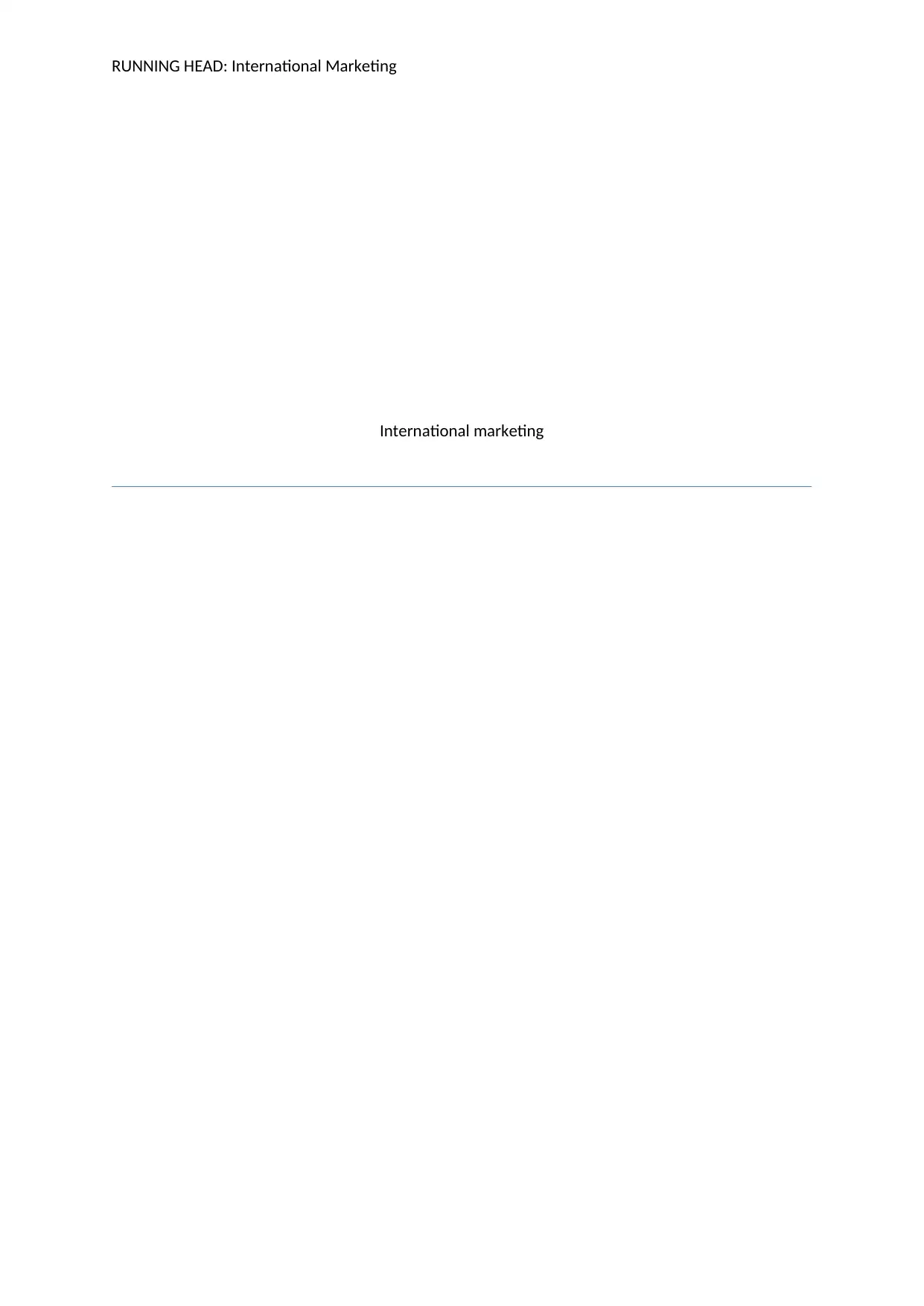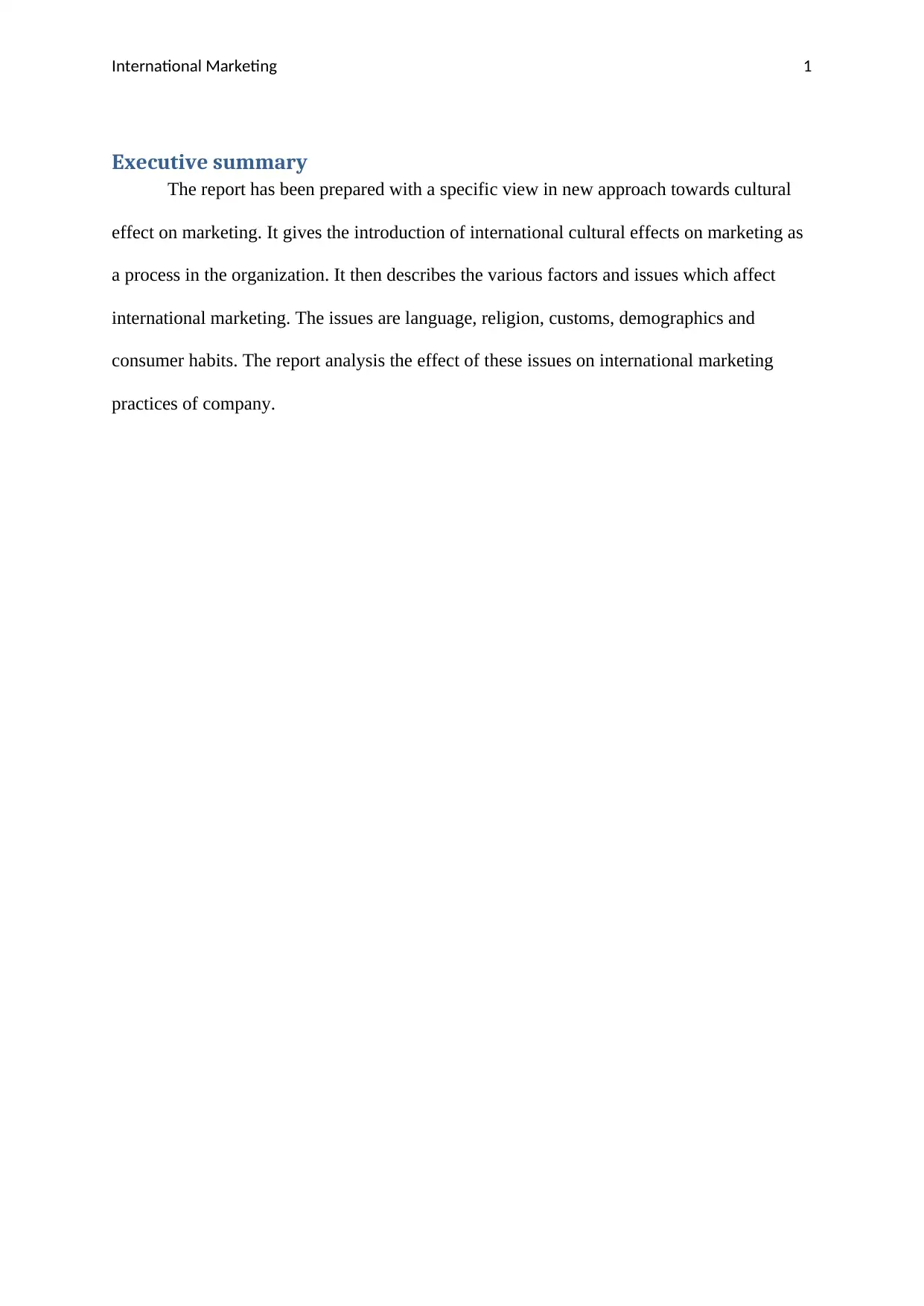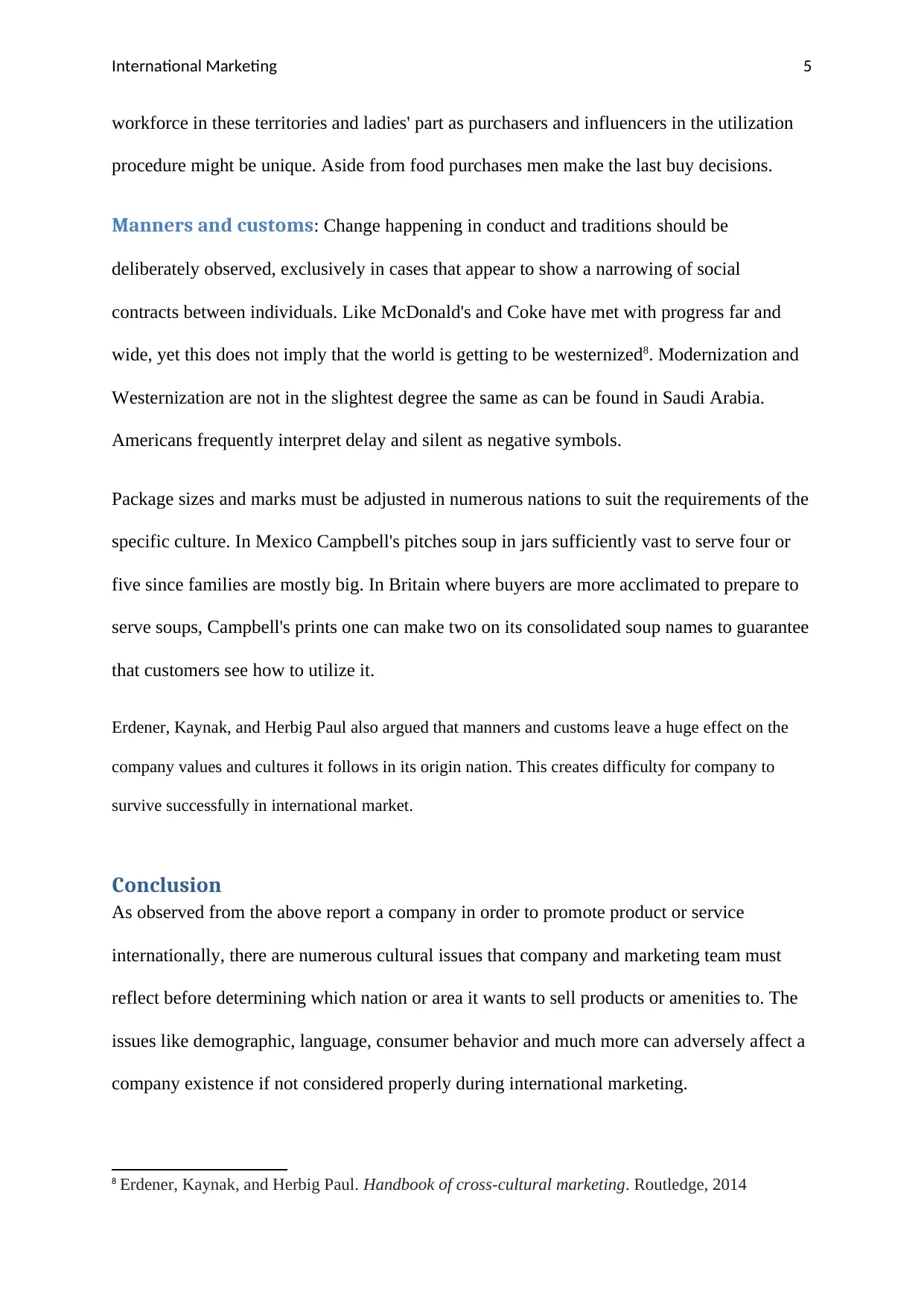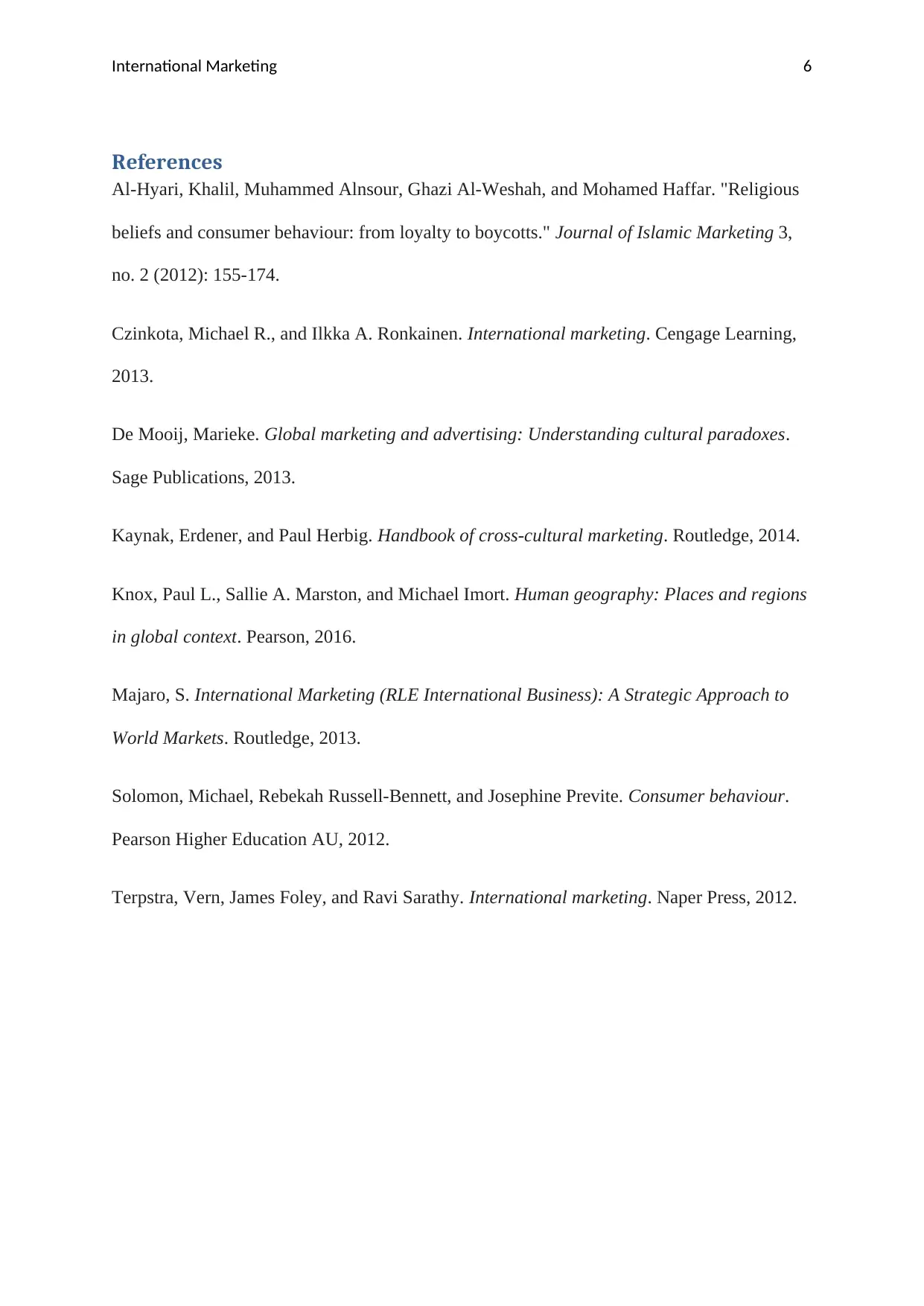International Marketing: Analyzing Cultural Effects and Strategies
VerifiedAdded on 2020/03/16
|7
|1459
|272
Report
AI Summary
This report provides an executive summary and introduction to the effects of culture on international marketing, emphasizing the differences between domestic and international marketing. It delves into key cultural factors, including language, demographics, consumer habits, religion, and customs, and analyzes their impact on marketing practices. The report highlights the challenges companies face, such as language barriers and differing consumer behaviors shaped by cultural values and religious beliefs. It explores how these factors influence marketing strategies, from product naming and packaging to advertising and market segmentation. The conclusion stresses the importance of considering these cultural nuances when planning international marketing campaigns to avoid potential pitfalls and ensure successful market entry and expansion. The report references several scholarly articles to support its findings, providing a comprehensive overview of the subject.

RUNNING HEAD: International Marketing
International marketing
International marketing
Paraphrase This Document
Need a fresh take? Get an instant paraphrase of this document with our AI Paraphraser

International Marketing 1
Executive summary
The report has been prepared with a specific view in new approach towards cultural
effect on marketing. It gives the introduction of international cultural effects on marketing as
a process in the organization. It then describes the various factors and issues which affect
international marketing. The issues are language, religion, customs, demographics and
consumer habits. The report analysis the effect of these issues on international marketing
practices of company.
Executive summary
The report has been prepared with a specific view in new approach towards cultural
effect on marketing. It gives the introduction of international cultural effects on marketing as
a process in the organization. It then describes the various factors and issues which affect
international marketing. The issues are language, religion, customs, demographics and
consumer habits. The report analysis the effect of these issues on international marketing
practices of company.

International Marketing 2
Introduction
International marketing is altogether different from domestic marketing. There is a host of
issues which affect marketing practices by companies in international marketing which a
business need not manage when promoting in their own nation. The main issues which
company constantly faces are cultural issue due to which policies and practices need to be
framed keeping in mind the perquisites of the nation.
Key issues in international marketing
Language: The issue of language creates huge problems for international marketing. The
language is considered as a significant element in culture. The companies should be aware of
the difference in regional languages before doing any marketing practices. For instance: one
same word has a different meaning in different languages1. This is to be given main
consideration especially when doing verbal marketing. Like in some countries people shake
head to convey yes but in some countries shaking head is taken as opposite in the context of
language. Terpstra, Vern, James Foley, and Ravi Sarathy argued that there have stayed some
awkward errors in the worldwide promotion which did not help corporations sell their
merchandise2. The latest instance nobody at General Motors understood the interpretation for
the name of their car, the "Nova" which signified "it won't go" in South America. According
to Majaro, Gerber ltd also utilized a similar packaging with the charming little child on it they
had utilized for packaging its infant nourishment in Africa; they didn't understand that with
the high ignorance rate in Africa that it was normal for food packaging to show a photo of the
ingredients inside.
1 Vern Terpstra, Foley James, and Sarathy Ravi. International marketing. Naper Press, 2012
2 Majaro, Simon. International Marketing (RLE International Business): A Strategic Approach to
World Markets. Routledge, 2013.
Introduction
International marketing is altogether different from domestic marketing. There is a host of
issues which affect marketing practices by companies in international marketing which a
business need not manage when promoting in their own nation. The main issues which
company constantly faces are cultural issue due to which policies and practices need to be
framed keeping in mind the perquisites of the nation.
Key issues in international marketing
Language: The issue of language creates huge problems for international marketing. The
language is considered as a significant element in culture. The companies should be aware of
the difference in regional languages before doing any marketing practices. For instance: one
same word has a different meaning in different languages1. This is to be given main
consideration especially when doing verbal marketing. Like in some countries people shake
head to convey yes but in some countries shaking head is taken as opposite in the context of
language. Terpstra, Vern, James Foley, and Ravi Sarathy argued that there have stayed some
awkward errors in the worldwide promotion which did not help corporations sell their
merchandise2. The latest instance nobody at General Motors understood the interpretation for
the name of their car, the "Nova" which signified "it won't go" in South America. According
to Majaro, Gerber ltd also utilized a similar packaging with the charming little child on it they
had utilized for packaging its infant nourishment in Africa; they didn't understand that with
the high ignorance rate in Africa that it was normal for food packaging to show a photo of the
ingredients inside.
1 Vern Terpstra, Foley James, and Sarathy Ravi. International marketing. Naper Press, 2012
2 Majaro, Simon. International Marketing (RLE International Business): A Strategic Approach to
World Markets. Routledge, 2013.
⊘ This is a preview!⊘
Do you want full access?
Subscribe today to unlock all pages.

Trusted by 1+ million students worldwide

International Marketing 3
Demographics: The span of the populace is a critical determinant of interest for some
items. There are nations with just a couple of lakh of individuals from one viewpoint and
those with several million then again. As per a World Development Report, there were 58
nations with a population of lesser than one million3. And these nations are less attractive to
business ventures. Poor nations with little population are by and large not appealing for
business. Paul also stated that even nations may hold out open doors for some organizations.
As these business sectors may not be of significant importance for big organizations, little
companies can discover promising specialties in these business sectors.
Age and different demographic assume a key part in global promotion similarly as they do in
national marketing; organizations need to give careful consideration to them. The
organization is most likely not going to need to market laptops to senior nationals in an
underdeveloped nation where there is no access to the internet and where an extensive level
of the residents more than 60 are computer ignorant4. This represents the significance of
understanding age and different demographics on a potential nation that should be targeted
for products or services to since they are both strong and utilized as a part of deciding on
advertising selection.
Consumer habits:
Culture and personality combine to shape consumer behavior in every particular region of the
world or country. Regardless of globalization, individuals from various countries keep on
having their own particular unique habits and tastes, their qualities and standards established
in their national societies5. It is also a fact that there is no experimental proof to demonstrate
3 Paul Knox, L., Marston, Sallie A., and Imort Michael. Human geography: Places and regions in
global context. Pearson, 2016.
4 Mooij De, Marieke. Global marketing and advertising: Understanding cultural paradoxes. Sage
Publications, 2013.
5 Michael R., Czinkota, and Ronkainen Ilkka A.. International marketing. Cengage Learning, 2013.
Demographics: The span of the populace is a critical determinant of interest for some
items. There are nations with just a couple of lakh of individuals from one viewpoint and
those with several million then again. As per a World Development Report, there were 58
nations with a population of lesser than one million3. And these nations are less attractive to
business ventures. Poor nations with little population are by and large not appealing for
business. Paul also stated that even nations may hold out open doors for some organizations.
As these business sectors may not be of significant importance for big organizations, little
companies can discover promising specialties in these business sectors.
Age and different demographic assume a key part in global promotion similarly as they do in
national marketing; organizations need to give careful consideration to them. The
organization is most likely not going to need to market laptops to senior nationals in an
underdeveloped nation where there is no access to the internet and where an extensive level
of the residents more than 60 are computer ignorant4. This represents the significance of
understanding age and different demographics on a potential nation that should be targeted
for products or services to since they are both strong and utilized as a part of deciding on
advertising selection.
Consumer habits:
Culture and personality combine to shape consumer behavior in every particular region of the
world or country. Regardless of globalization, individuals from various countries keep on
having their own particular unique habits and tastes, their qualities and standards established
in their national societies5. It is also a fact that there is no experimental proof to demonstrate
3 Paul Knox, L., Marston, Sallie A., and Imort Michael. Human geography: Places and regions in
global context. Pearson, 2016.
4 Mooij De, Marieke. Global marketing and advertising: Understanding cultural paradoxes. Sage
Publications, 2013.
5 Michael R., Czinkota, and Ronkainen Ilkka A.. International marketing. Cengage Learning, 2013.
Paraphrase This Document
Need a fresh take? Get an instant paraphrase of this document with our AI Paraphraser

International Marketing 4
homogenization of tastes or the presence of widespread price-minded of customer sections.
Culture is vibrant and is continuously affected by variations in environment in social
establishments and person’s own esteems6. The mutual cultural values need business to fit
according to the social and economic reward opportunities to which persons should adjust
and in which they invest the majority of their energy (relatives, universities, societies, and
many more) to work effortlessly and successfully. Individuals belonging to the particular
nation with a specific national culture are liable to the contentions and compatibilities, which
they follow. According to Ilkka A. Ronkainen it is difficult for organization to fit in any
culture with ease as diverse culture imposes many restrictions on company to explore its
operations.
Religion:
Religion affects international marketing that is found in a culture's esteems and states of mind
toward enterprise, consumption, and social association. The effect will fluctuate contingent
upon the quality of the overwhelming religious tents. While religion's effect might be very
twisting in Northern Europe, its effect in nations where Islam religion is on the rise might be
significant.
Al-Hyari Khalil also argued that religion gives the premise to cultural similarities under
shared opinions and conduct. The effect of these likenesses will be evaluated regarding the
overwhelming religions of the world Christianity, Islam, Hinduism, Buddhism, and
Confucianism. The part of ladies in business is attached to religion, particularly in the Middle
East where they are not ready to work as they would in the West7. The impacts of this are
various for instance a firm might be constrained in its utilization of female directors or
6 Michael, Solomon, Russell-Bennett, Rebekah and Previte, Josephine. Consumer behaviour. Pearson
Higher Education AU, 2012.
7 Khalil, Al-Hyari, et al., "Religious beliefs and consumer behaviour: from loyalty to
boycotts." Journal of Islamic Marketing 3, no. 2 (2012): 155-174.
homogenization of tastes or the presence of widespread price-minded of customer sections.
Culture is vibrant and is continuously affected by variations in environment in social
establishments and person’s own esteems6. The mutual cultural values need business to fit
according to the social and economic reward opportunities to which persons should adjust
and in which they invest the majority of their energy (relatives, universities, societies, and
many more) to work effortlessly and successfully. Individuals belonging to the particular
nation with a specific national culture are liable to the contentions and compatibilities, which
they follow. According to Ilkka A. Ronkainen it is difficult for organization to fit in any
culture with ease as diverse culture imposes many restrictions on company to explore its
operations.
Religion:
Religion affects international marketing that is found in a culture's esteems and states of mind
toward enterprise, consumption, and social association. The effect will fluctuate contingent
upon the quality of the overwhelming religious tents. While religion's effect might be very
twisting in Northern Europe, its effect in nations where Islam religion is on the rise might be
significant.
Al-Hyari Khalil also argued that religion gives the premise to cultural similarities under
shared opinions and conduct. The effect of these likenesses will be evaluated regarding the
overwhelming religions of the world Christianity, Islam, Hinduism, Buddhism, and
Confucianism. The part of ladies in business is attached to religion, particularly in the Middle
East where they are not ready to work as they would in the West7. The impacts of this are
various for instance a firm might be constrained in its utilization of female directors or
6 Michael, Solomon, Russell-Bennett, Rebekah and Previte, Josephine. Consumer behaviour. Pearson
Higher Education AU, 2012.
7 Khalil, Al-Hyari, et al., "Religious beliefs and consumer behaviour: from loyalty to
boycotts." Journal of Islamic Marketing 3, no. 2 (2012): 155-174.

International Marketing 5
workforce in these territories and ladies' part as purchasers and influencers in the utilization
procedure might be unique. Aside from food purchases men make the last buy decisions.
Manners and customs: Change happening in conduct and traditions should be
deliberately observed, exclusively in cases that appear to show a narrowing of social
contracts between individuals. Like McDonald's and Coke have met with progress far and
wide, yet this does not imply that the world is getting to be westernized8. Modernization and
Westernization are not in the slightest degree the same as can be found in Saudi Arabia.
Americans frequently interpret delay and silent as negative symbols.
Package sizes and marks must be adjusted in numerous nations to suit the requirements of the
specific culture. In Mexico Campbell's pitches soup in jars sufficiently vast to serve four or
five since families are mostly big. In Britain where buyers are more acclimated to prepare to
serve soups, Campbell's prints one can make two on its consolidated soup names to guarantee
that customers see how to utilize it.
Erdener, Kaynak, and Herbig Paul also argued that manners and customs leave a huge effect on the
company values and cultures it follows in its origin nation. This creates difficulty for company to
survive successfully in international market.
Conclusion
As observed from the above report a company in order to promote product or service
internationally, there are numerous cultural issues that company and marketing team must
reflect before determining which nation or area it wants to sell products or amenities to. The
issues like demographic, language, consumer behavior and much more can adversely affect a
company existence if not considered properly during international marketing.
8 Erdener, Kaynak, and Herbig Paul. Handbook of cross-cultural marketing. Routledge, 2014
workforce in these territories and ladies' part as purchasers and influencers in the utilization
procedure might be unique. Aside from food purchases men make the last buy decisions.
Manners and customs: Change happening in conduct and traditions should be
deliberately observed, exclusively in cases that appear to show a narrowing of social
contracts between individuals. Like McDonald's and Coke have met with progress far and
wide, yet this does not imply that the world is getting to be westernized8. Modernization and
Westernization are not in the slightest degree the same as can be found in Saudi Arabia.
Americans frequently interpret delay and silent as negative symbols.
Package sizes and marks must be adjusted in numerous nations to suit the requirements of the
specific culture. In Mexico Campbell's pitches soup in jars sufficiently vast to serve four or
five since families are mostly big. In Britain where buyers are more acclimated to prepare to
serve soups, Campbell's prints one can make two on its consolidated soup names to guarantee
that customers see how to utilize it.
Erdener, Kaynak, and Herbig Paul also argued that manners and customs leave a huge effect on the
company values and cultures it follows in its origin nation. This creates difficulty for company to
survive successfully in international market.
Conclusion
As observed from the above report a company in order to promote product or service
internationally, there are numerous cultural issues that company and marketing team must
reflect before determining which nation or area it wants to sell products or amenities to. The
issues like demographic, language, consumer behavior and much more can adversely affect a
company existence if not considered properly during international marketing.
8 Erdener, Kaynak, and Herbig Paul. Handbook of cross-cultural marketing. Routledge, 2014
⊘ This is a preview!⊘
Do you want full access?
Subscribe today to unlock all pages.

Trusted by 1+ million students worldwide

International Marketing 6
References
Al-Hyari, Khalil, Muhammed Alnsour, Ghazi Al-Weshah, and Mohamed Haffar. "Religious
beliefs and consumer behaviour: from loyalty to boycotts." Journal of Islamic Marketing 3,
no. 2 (2012): 155-174.
Czinkota, Michael R., and Ilkka A. Ronkainen. International marketing. Cengage Learning,
2013.
De Mooij, Marieke. Global marketing and advertising: Understanding cultural paradoxes.
Sage Publications, 2013.
Kaynak, Erdener, and Paul Herbig. Handbook of cross-cultural marketing. Routledge, 2014.
Knox, Paul L., Sallie A. Marston, and Michael Imort. Human geography: Places and regions
in global context. Pearson, 2016.
Majaro, S. International Marketing (RLE International Business): A Strategic Approach to
World Markets. Routledge, 2013.
Solomon, Michael, Rebekah Russell-Bennett, and Josephine Previte. Consumer behaviour.
Pearson Higher Education AU, 2012.
Terpstra, Vern, James Foley, and Ravi Sarathy. International marketing. Naper Press, 2012.
References
Al-Hyari, Khalil, Muhammed Alnsour, Ghazi Al-Weshah, and Mohamed Haffar. "Religious
beliefs and consumer behaviour: from loyalty to boycotts." Journal of Islamic Marketing 3,
no. 2 (2012): 155-174.
Czinkota, Michael R., and Ilkka A. Ronkainen. International marketing. Cengage Learning,
2013.
De Mooij, Marieke. Global marketing and advertising: Understanding cultural paradoxes.
Sage Publications, 2013.
Kaynak, Erdener, and Paul Herbig. Handbook of cross-cultural marketing. Routledge, 2014.
Knox, Paul L., Sallie A. Marston, and Michael Imort. Human geography: Places and regions
in global context. Pearson, 2016.
Majaro, S. International Marketing (RLE International Business): A Strategic Approach to
World Markets. Routledge, 2013.
Solomon, Michael, Rebekah Russell-Bennett, and Josephine Previte. Consumer behaviour.
Pearson Higher Education AU, 2012.
Terpstra, Vern, James Foley, and Ravi Sarathy. International marketing. Naper Press, 2012.
1 out of 7
Related Documents
Your All-in-One AI-Powered Toolkit for Academic Success.
+13062052269
info@desklib.com
Available 24*7 on WhatsApp / Email
![[object Object]](/_next/static/media/star-bottom.7253800d.svg)
Unlock your academic potential
Copyright © 2020–2025 A2Z Services. All Rights Reserved. Developed and managed by ZUCOL.




